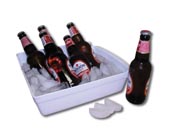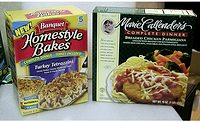
Casein can be formulated to make cold water resistant, ice-proof bottle labeling adhesives, which, when properly formulated, can be removed in an alkaline soaker.
Although other adhesive technologies and forms, such as hot melts, have taken some market share in recent years, natural-based waterborne adhesives are still very popular, are growing in volume and will be used for many years to come. They are the adhesives of choice in many industries.
This article will focus on the use of starch- and casein-based adhesives for labeling, and the use of dextrin-based adhesives in the envelope market.
Natural Adhesives for P&C Applications
Contrary to popular belief, hot melts do not dominate the packaging and converting (P&C) industries. All available information points to P&C adhesives being primarily waterborne and suggests that a sizable percentage of these adhesives are natural based.Following are some statistics.
- U.S. formulated adhesive industry - P&C 47%, waterborne 58.9%.1
- Natural-based adhesives, from a global standpoint, comprise about 37% of the total demand.2
- Starch and dextrin adhesives account for approximately 58% of the U.S. packaging market.3
Seeing these figures, one has to wonder if flexible packaging, corrugated starches, etc., are included. At any rate, there is no doubt that P&C is a large adhesive market and that natural-based adhesives are an important part of that market - although frequently ignored.
Waterborne adhesives are certainly a mature technology. However, the market is very large and one can sell adhesives to many of the P&C adhesive markets as specialty products. In addition, some of the newest adhesive developments, such as reactive hot melts, 100%-solids flexible packaging adhesives, and low-temperature-application hot melts, have been funded by the sales profits of waterborne adhesives. This will continue in the years ahead.
Waterborne adhesives and natural-based products are alive and well. They continue to grow in use, although at a slower rate than hot melts.
This article will concentrate on the P&C markets, waterborne adhesives, and natural-based waterborne adhesives.
Types of Natural-Based Adhesives
The major natural-based waterborne adhesives used for P&C are those based upon starch, dextrin, and casein. Major markets for these products include the following.- Starch - labeling (jelly gum), envelope, bags and sacks, bookbinding, tissue and towels, cigarettes
- Dextrin - general packaging, labeling, case and carton sealing and forming, envelopes and gumming, bags and sacks, tube and core winding, tissue and towels, laminating, cigarette packaging
- Casein - labeling
Starch-Based Adhesives
Starches used in the U.S. adhesives industry are primarily those based on maize (corn), waxy maize, tapioca and potato. Corn-based products are most widely used. Some adhesives will have a mixture of various types of starches. Raw and acid fluidities and oxidized starches are used to make adhesives. Also see comments under the labeling section to follow.
Dextrin-Based Adhesives
Dextrins are widely used in the P&C industry. Dextrins are composed of starches converted by acid, heat or a combination of both. There are slightly converted dextrines, highly converted dextrins and ones in between.
Generally, the higher the conversion, the higher the water solubility; likewise, the higher the solids, the tackier the adhesive, but the poorer the adhesion. Dextrins can be classified by the type of conversion and the extent of the conversion - white dextrines, yellow dextrines and British gums. Where greater tack, solubility, remoistenability and clarity are desired, root dextrines (tapioca or potato) are used, such as in envelope front seals.
Borated dextrines are widely used for P&C. Borated dextrines are what the name implies - dextrin, borax, and, in most cases, sodium hydroxide. The borax increases the tack and speed, and the caustic reinforces the borax effect.
Casein-Based Adhesives
Casein-based adhesives are widely used for the labeling of glassware. An example is the large consumption of adhesives in breweries.
Casein is a dry protein obtained from cow's milk. It can be formulated to make cold water resistant, icewater-proof (IWR) bottle labeling adhesives, which, when properly formulated, can be removed in an alkaline soaker.
Markets
Glass Bottle Labeling and EnvelopesThe labeling market is a very large one. It has been estimated that it represents about 6% of the packaging market.4 At least 50% of the labels used are glue applied. Some 90% of the labels used in the food and beverage markets are glue applied.4
The three main types of adhesives used for glass bottle labeling are starch-based (jelly gum), casein and non-casein. The sidebar shows a comparison of these three types of adhesives.
Starch-based jelly gums (alkaline types) are made by slurrying the starch in water, heating, and mixing with sodium hydroxide to convert the starch into a viscous mass. Acids are used to stop the conversion of the starch at the desired point. Other additives, such as deformers, preservatives and salts, are used. pH control is important.
The starch used to make jelly gums can be waxy maize, potato, tapioca, sago or a combination of these. Each starch will give slightly different properties.
Jelly gums are very tacky adhesives with good adhesion to glassware, but they do not have IWR. Jelly gums can be formulated to run well on picker and rotary labelers.
Casein is obtained from cow's milk and thus is subject to the whims of nature, the season, cost, and importation. However, casein-based IWR adhesives are excellent machining products on rotary- and picker-type labelers, and, when properly formulated, have IWR but can be removed in alkaline soakers such as those used in breweries. IWR casein adhesives contain casein, a peptizer, a crosslinker to provide IWR, ammonia, and perhaps some starch, preservatives, defoamers, etc. IWR casein-based adhesives are fast and tacky and can adhere to moist glassware. Casein-based adhesives are sometimes subject to bacterial attack.
A non-casein IWR labeling adhesive is the name given to products formulated to have IWR that still do not contain casein. They are based upon starch, special polymers and resin additives. They have very good IWR but are more difficult to remove in alkaline soakers than casein adhesives. In addition, these types of adhesives sometimes have a very strong ammonia odor.
Envelopes
Dextrines are widely used as the base for the remoistenable adhesive (called the front seal gum) used on an envelope. Front seals must have: good adhesion to a variety of paper stocks; a light color; gloss; a flat lay; the ability to dry quickly; high-humidity resistance to prevent blocking; and the ability to machine well.
The dextrines used in envelope front seals are generally root starch-based because root starch dextrines have better clarity and stability than maize-based starch dextrines. It is possible to make an envelope front seal using a combination of root and maize dextrines. "Yellow" dextrines and British gum dextrines used for envelope front seals are highly converted dextrines.
Envelope dextrin front seals are formulated from dextrin, bleaching agents, stabilizers, various types of humectants, wetting agents and preservatives. Typical dextrin front seals have a viscosity of 6000-9000 cps and a solids content of 65% or so.
In addition to the "all dextrin" front seals, there are dextrin + vinyl resin formulas (generally 10-25% or so of vinyl resin) and vinyl resin + dextrin formulas (generally 60% or so of vinyl resin).
The dextrin-compatible vinyl acetate resin emulsion provides faster drying speed, adhesion and tack when remoistened.
Trends and Opportunities
Labeling- Improved machining IWR casein adhesives - less splashing and slinging, even at speeds in excess of 1000 bpm
- Non-casein IWR adhesives with improved removability in alkaline soakers
- Growth of sleeve and wraparound roll-fed film labels using hot melts
- UV-curable hot melts for shink labels with high shrink
Envelopes
- Improved non-splashing, non-throwing, clean-transfer, good-adhesion and minimal penetration starch-based back seam gums
- Good-machining window gums
- Front seals with superior adhesion to a variety of paper stocks
- Front seals with an optimum balance between non curl, high humidity blocking resistance, gloss, speed and cost effectiveness
Conclusion
The waterborne adhesive market is a mature market; natural-based products are generally considered mature as well. However, that does not mean that all of these types of products should be presented and sold as commodities. Adhesives are specialty products. Some industries need such specialty adhesives - products with special properties of value to the customer along with close sales and technical support. Industries where this is possible include the ones mentioned, but there are others.This article is based on a paper presented at the Spring 2004 Adhesive and Sealant Council, Inc. meeting in Cleveland.

